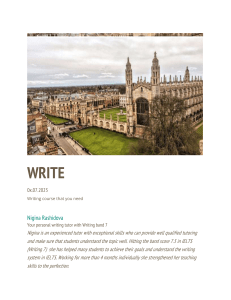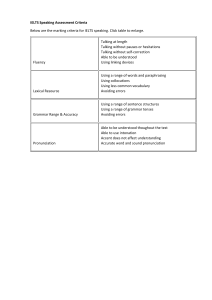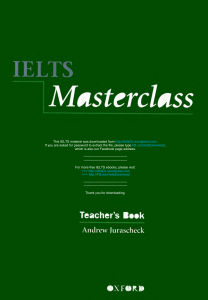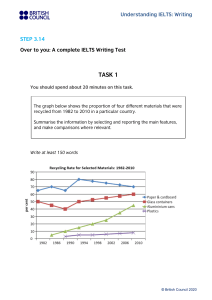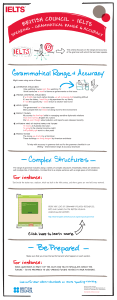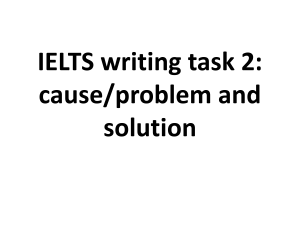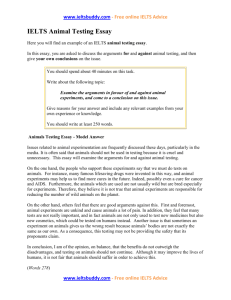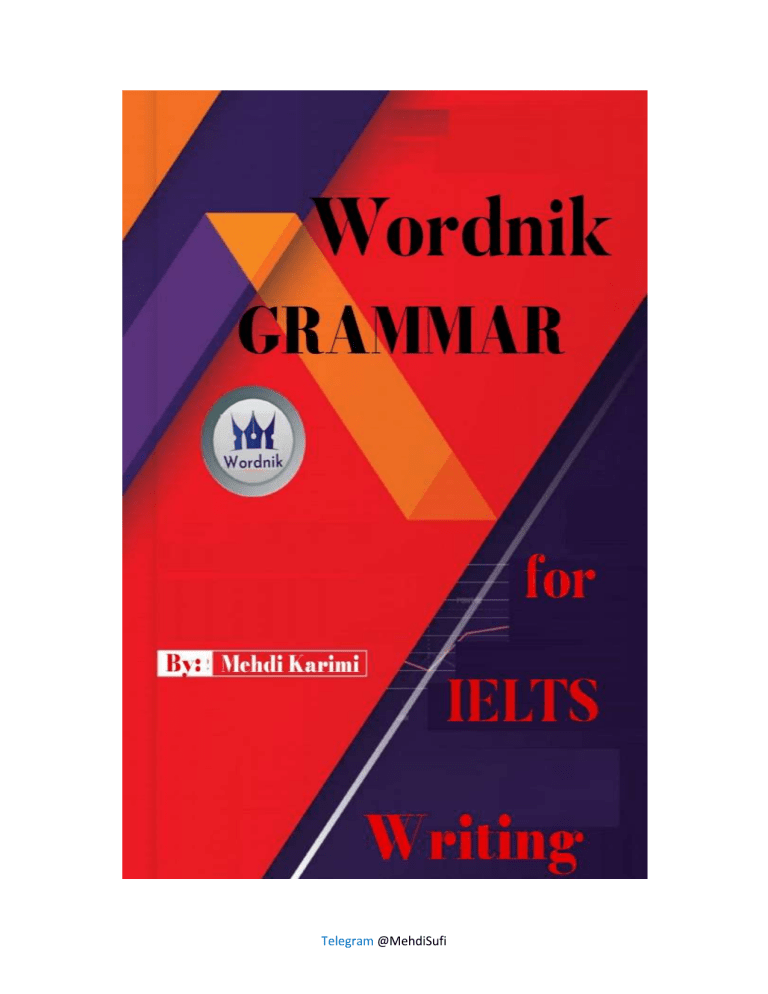
Telegram @MehdiSufi Wordnik Grammar for IELTS Writing: A Comprehensive Guide to Achieving High Scores" By: Mehdi Karimi Telegram @MehdiSufi Introduction: The International English Language Testing System (IELTS) is a widely recognized exam that assesses a candidate's proficiency in English. It is used by many universities, employers, and immigration agencies as a measure of a candidate's language skills. One of the four sections of the IELTS test is the Writing section, which requires test takers to write two tasks. To achieve a high score in the Writing section, it is essential to have excellent grammar skills. "Mastering Grammar for IELTS Writing" is a comprehensive guide that focuses on improving grammar skills specifically for the Writing section of the IELTS exam. The book is designed to help candidates of all levels, from beginners to advanced, to master the essential grammar rules needed to achieve high scores. The book covers a wide range of grammar topics, including sentence structure, verb tenses, subject-verb agreement, and much more. With this book, test takers will gain a deep understanding of the grammar rules, as well as the skills needed to apply them effectively in their writing. Each chapter contains detailed explanations, examples, and practice exercises to reinforce learning. By the end of the book, test takers will be well-equipped with the necessary tools to achieve a high score in the Writing section of the IELTS exam. Telegram @MehdiSufi Chapter 1: Introduction to IELTS Writing In this chapter, readers will learn about the IELTS Writing section, its format, and what the examiners are looking for. The chapter provides an overview of the two writing tasks, the time allotted for each task, and the marking criteria. Readers will also be introduced to the different types of writing styles they may encounter in the exam. Chapter 2: Understanding Sentence Structure This chapter focuses on the essential building block of writing, the sentence. Readers will learn about the different types of sentence structures, including simple, compound, and complex sentences. The chapter also covers common mistakes to avoid, such as sentence fragments and run-on sentences. Chapter 3: Verb Tenses In this chapter, readers will learn about verb tenses and their appropriate use in writing. The chapter covers the basics of past, present, and future tenses, as well as more advanced tenses such as present perfect and past perfect. Chapter 4: Subject-Verb Agreement This chapter covers the important rule of subject-verb agreement, which ensures that the verb matches the subject in number and person. Readers will learn about the different types of subjects and how to identify them, as well as the different forms of verbs and their correct usage. Chapter 5: Nouns and Pronouns This chapter focuses on the use of nouns and pronouns in writing. Readers will learn about the different types of nouns and pronouns, as well as their function in a sentence. The chapter also covers common mistakes to avoid, such as incorrect pronoun use and pronoun agreement errors. Chapter 6: Adjectives and Adverbs This chapter covers the use of adjectives and adverbs in writing. Readers will learn about the different types of adjectives and adverbs, as well as their placement in a sentence. The chapter Telegram @MehdiSufi also covers common mistakes to avoid, such as overusing adjectives and adverbs and using them incorrectly. Chapter 7: Articles and Determiners In this chapter, readers will learn about articles and determiners and their appropriate use in writing. The chapter covers the basics of indefinite and definite articles, as well as the different types of determiners and their usage. Chapter 8: Prepositions and Conjunctions This chapter focuses on the use of prepositions and conjunctions in writing. Readers will learn about the different types of prepositions and their appropriate use in a sentence, as well as common mistakes to avoid, such as incorrect preposition placement and missing conjunctions. Chapter 9: Complex Sentences In this chapter, readers will learn how to construct complex sentences. The chapter covers the use of subordinating conjunctions and relative pronouns to create complex sentences. Readers will also learn how to avoid common mistakes, such as using run-on sentences or sentence fragments. Chapter 10: Punctuation This chapter focuses on the correct use of punctuation in writing. Readers will learn about the different types of punctuation marks, including commas, periods, semicolons, and colons. The chapter covers the rules for using punctuation marks correctly, as well as common mistakes to avoid. Chapter 11: Cohesion and Coherence This chapter covers the important concepts of cohesion and coherence in writing. Readers will learn how to create cohesive and coherent paragraphs by using appropriate transition words and phrases. The chapter also covers the importance of maintaining a logical flow of ideas in writing. Chapter 12: Formal Writing Style Telegram @MehdiSufi In this chapter, readers will learn about the formal writing style required for the IELTS exam. The chapter covers the use of appropriate vocabulary, sentence structure, and tone to create a formal writing style. Readers will also learn how to avoid common mistakes, such as using informal language or contractions. Chapter 13: Common Mistakes to Avoid This chapter focuses on common mistakes made by test takers in the IELTS Writing section. Readers will learn about the most frequent errors made in grammar, vocabulary, and punctuation, as well as how to avoid them. The chapter also provides tips on how to proofread and edit writing effectively. Chapter 14: Practice Exercises This chapter provides practice exercises to reinforce the grammar rules and concepts covered in the previous chapters. Readers will have the opportunity to practice writing in a variety of styles, including opinion essays, problem-solution essays, and reports. The chapter also includes sample answers and feedback for each exercise. Chapter 15: Tips for Exam Day In this final chapter, readers will learn essential tips for exam day. The chapter covers how to manage time effectively, how to approach each writing task, and how to stay calm and focused during the exam. Readers will also receive advice on how to prepare for the exam, including study tips and resources. In conclusion, "Mastering Grammar for IELTS Writing" is a comprehensive guide that covers all the essential grammar rules and concepts needed to achieve high scores in the IELTS Writing section. By using this book, test takers will gain a deep understanding of grammar and writing techniques and will be well-equipped to succeed on exam day. Telegram @MehdiSufi Chapter 1: Introduction to IELTS Writing The International English Language Testing System (IELTS) is a standardized test used to assess the language proficiency of non-native English speakers. The test is divided into four sections: Listening, Reading, Writing, and Speaking. The Writing section of the IELTS exam consists of two tasks, each requiring test takers to write an essay on a given topic. Task 1 of the Writing section requires test takers to describe a visual diagram, graph, or chart in a minimum of 150 words. In contrast, Task 2 requires test takers to write an essay expressing their opinion or discussing a given topic in a minimum of 250 words. Task 2 carries more weightage and is given more importance in the evaluation of the Writing section. The IELTS Writing section is scored on a scale of 0-9, with 0 being the lowest and 9 being the highest. The score is based on four criteria: Task Achievement, Coherence and Cohesion, Vocabulary, and Grammar. Grammar plays a vital role in the evaluation of the Writing section, as it is one of the four criteria used to assess a test taker's performance. Therefore, it is essential to have a strong grasp of grammar rules and concepts to succeed in the IELTS Writing section. "Mastering Grammar for IELTS Writing" is a comprehensive guide that covers all the essential grammar rules and concepts needed to achieve high scores in the IELTS Writing section. This book is designed to help test takers improve their grammar skills and enhance their writing abilities. The book is divided into fifteen chapters, each covering a different aspect of grammar and writing. The chapters are organized in a logical sequence, starting with the basics of grammar and gradually progressing to more advanced concepts. Each chapter includes detailed explanations, examples, and exercises to help readers practice and reinforce their understanding of the grammar rules and concepts. In the next chapters, we will discuss each chapter of the book in detail. Telegram @MehdiSufi Chapter 2: Parts of Speech Before we dive into the specific rules of grammar, it is essential to understand the basic building blocks of language: the parts of speech. The parts of speech are the basic categories into which words are classified based on their function in a sentence. The eight parts of speech are: 1. Noun - a person, place, thing, or idea 2. Pronoun - a word that takes the place of a noun 3. Verb - an action or state of being 4. Adjective - a word that describes a noun or pronoun 5. Adverb - a word that describes a verb, adjective, or other adverb 6. Preposition - a word that shows the relationship between a noun or pronoun and other words in a sentence 7. Conjunction - a word that connects words, phrases, or clauses 8. Interjection - a word or phrase used to express strong emotion or surprise Understanding the function and usage of each part of speech is crucial in constructing effective sentences and writing essays. In this chapter, we will go over each part of speech in detail, providing examples and practice exercises to help you master their usage. Nouns are the most common part of speech used in sentences. They can be singular or plural, and they can function as the subject, object, or possessive in a sentence. Pronouns, on the other hand, are used to replace nouns and avoid repetition in a sentence. They can be personal, possessive, reflexive, or relative pronouns. Verbs are the action words in a sentence and can be used in different tenses to indicate the time of the action. Adjectives are used to describe nouns and pronouns, and they come before the noun they describe. Adverbs are used to describe verbs, adjectives, or other adverbs and can be used to modify the degree or intensity of an action. Prepositions are used to indicate the relationship between a noun or pronoun and other words in a sentence. They can be used to show location, time, direction, and other relationships. Conjunctions are used to connect words, phrases, or clauses in a sentence, and they can be Telegram @MehdiSufi coordinating, subordinating, or correlative. Interjections are used to express strong emotions and can be used to add emphasis or surprise to a sentence. By understanding the different parts of speech and their functions, you will be better equipped to construct grammatically correct and effective sentences. Practice exercises in this chapter will help you reinforce your understanding of the different parts of speech and how they are used in sentences. Chapter 3: Sentence Structure Now that you have a basic understanding of the parts of speech, it is time to put them together to form sentences. Understanding sentence structure is important in constructing clear and effective sentences. In this chapter, we will go over the different types of sentence structures, including simple sentences, compound sentences, and complex sentences. A simple sentence is a sentence with one independent clause, which contains a subject and a verb and expresses a complete thought. For example, "The dog barks loudly." A compound sentence is a sentence with two or more independent clauses joined by a coordinating conjunction. For example, "The dog barks loudly, and the cat runs away." In this example, "and" is the coordinating conjunction. A complex sentence is a sentence with one independent clause and one or more dependent clauses. A dependent clause is a clause that cannot stand alone as a sentence and depends on the independent clause to make sense. For example, "When the dog barks loudly, the cat runs away." In this example, "When the dog barks loudly" is the dependent clause, and "the cat runs away" is the independent clause. It is also important to understand the different types of clauses in a sentence. An independent clause is a clause that can stand alone as a sentence, while a dependent clause cannot. A subordinate clause is a type of dependent clause that functions as an adjective, adverb, or noun in a sentence. In addition to understanding the different types of sentence structures and clauses, it is important to use proper punctuation in constructing sentences. Punctuation marks such as Telegram @MehdiSufi commas, semicolons, and periods are used to clarify the meaning of a sentence and make it easier to read. By understanding sentence structure and proper punctuation, you will be able to construct clear and effective sentences that convey your message effectively. Practice exercises in this chapter will help you reinforce your understanding of sentence structure and punctuation. Telegram @MehdiSufi Chapter 4: Common Sentence Errors Even with a good understanding of sentence structure and punctuation, it is common to make mistakes when writing. In this chapter, we will go over some common sentence errors to watch out for and how to correct them. 1. Run-on sentences: A run-on sentence occurs when two or more independent clauses are joined without proper punctuation or a conjunction. For example, "The dog barks loudly, the cat runs away." This sentence should be separated into two independent clauses with a comma and coordinating conjunction or a semicolon: "The dog barks loudly, and the cat runs away." or "The dog barks loudly; the cat runs away." 2. Sentence fragments: A sentence fragment is an incomplete sentence that is missing a subject, verb, or both. For example, "Running through the park." This sentence fragment can be corrected by adding a subject and a verb: "I enjoy running through the park." 3. Misplaced modifiers: A modifier is a word or phrase that describes or provides more information about another word or phrase in a sentence. A misplaced modifier occurs when the modifier is not placed near the word or phrase it is intended to modify, causing confusion. For example, "I saw the woman with the telescope walking down the street." In this sentence, it is unclear whether the woman or the telescope is walking down the street. This can be corrected by placing the modifier next to the word it is intended to modify: "I saw the woman walking down the street with the telescope." 4. Subject-verb agreement: A subject and verb must agree in number (singular or plural) in a sentence. For example, "The cat and the dog runs fast." This sentence should be corrected by making the verb agree with the plural subject: "The cat and the dog run fast." 5. Dangling modifiers: A dangling modifier occurs when the word or phrase being modified is not stated in the sentence. For example, "Walking through the park, the trees were beautiful." In this sentence, it is unclear what is walking through the park. This can be corrected by adding the word or phrase being modified: "Walking through the park, I saw that the trees were beautiful." Telegram @MehdiSufi By understanding and avoiding these common sentence errors, you can improve the clarity and effectiveness of your writing. Practice exercises in this chapter will help you reinforce your understanding of these concepts. Telegram @MehdiSufi Chapter 5: Advanced Grammar Structures for IELTS Writing To achieve a high score in IELTS writing, it is important to use a variety of grammatical structures, including some advanced structures. In this chapter, we will introduce some advanced grammar structures that can be used to improve the complexity and sophistication of your writing. 1. Inversion: Inversion is the reversal of the usual word order in a sentence. This can be done for emphasis or to make a sentence more complex. For example, instead of saying "I am going to the store," you could say "To the store am I going." This structure is especially useful for writing complex sentences in the IELTS exam. 2. Relative clauses: A relative clause is a type of dependent clause that describes or provides additional information about a noun or pronoun in the main clause of a sentence. For example, "The woman, who was wearing a red dress, walked down the street." The relative clause "who was wearing a red dress" provides additional information about the woman in the main clause. 3. Conditional sentences: Conditional sentences are used to describe hypothetical situations or events that depend on a particular condition. There are four types of conditional sentences, each with a different structure and use. For example, "If I had studied more, I would have passed the exam." This is an example of a third conditional sentence, which describes a past event that did not happen because a particular condition was not met. 4. Passive voice: The passive voice is used to focus on the action being performed rather than the person or thing performing the action. For example, instead of saying "The teacher corrected the papers," you could say "The papers were corrected by the teacher." This structure is useful for emphasizing the action or for writing more objectively. By incorporating these advanced grammar structures into your writing, you can add variety and complexity to your sentences, which can help you achieve a higher score on the IELTS exam. Practice exercises in this chapter will help you become more familiar with these structures and how to use them effectively. Telegram @MehdiSufi Chapter 6: Common Grammar Mistakes to Avoid in IELTS Writing In this chapter, we will focus on some common grammar mistakes that IELTS test-takers often make in their writing. These mistakes can significantly impact your score, so it is important to be aware of them and avoid them as much as possible. 1. Subject-verb agreement: One of the most common grammar mistakes in IELTS writing is subject-verb agreement. This means making sure that the subject and verb of a sentence match in number. For example, "The dogs barks" should be corrected to "The dogs bark" because dogs is plural and requires a plural verb. 2. Singular/plural nouns: Another common mistake is using singular or plural nouns incorrectly. For example, "The furniture in the room is old" is correct because furniture is a singular noun, but "The furnitures in the room are old" is incorrect because furnitures is not a word in English. 3. Articles: Using articles (a, an, the) correctly is important in IELTS writing. For example, "I saw an elephant in the zoo" is correct, but "I saw elephant in the zoo" is incorrect because an article is needed before the noun elephant. 4. Word order: In English, the order of words in a sentence is important for conveying meaning. For example, "He gave her the book" has a different meaning than "She gave him the book." It is important to make sure that the order of words in your sentences is clear and conveys the intended meaning. 5. Punctuation: Proper use of punctuation is also important in IELTS writing. Common punctuation mistakes include using commas incorrectly, using apostrophes incorrectly, and not using periods or other end-of-sentence punctuation. By being aware of these common grammar mistakes and practicing how to avoid them, you can significantly improve your score in the IELTS writing exam. In the next chapter, we will focus on some strategies for proofreading and editing your writing to catch and correct any mistakes. Telegram @MehdiSufi Chapter 7: Proofreading and Editing Strategies for IELTS Writing In this chapter, we will discuss some strategies for proofreading and editing your IELTS writing to ensure that it is error-free and polished. 1. Take a break: After finishing your writing, take a break before beginning the proofreading and editing process. This will give your brain a chance to rest and refresh, allowing you to approach your writing with fresh eyes. 2. Read out loud: When proofreading your writing, read it out loud. This will help you to identify any awkward or unclear sentences, as well as spelling and grammar mistakes. 3. Use a checklist: Create a checklist of common grammar and punctuation mistakes to look for, such as subject-verb agreement, article usage, and punctuation errors. This will help you to stay focused and ensure that you are checking for all the necessary mistakes. 4. Use spell-check and grammar-check tools: Most word processing programs have built-in spell-check and grammar-check tools that can help you to catch errors that you might have missed. However, be aware that these tools are not always 100% accurate and may miss some errors or suggest incorrect corrections. 5. Have someone else review your writing: Consider having a friend or tutor review your writing as well. They may be able to catch errors that you have missed and provide helpful feedback on areas that need improvement. By using these strategies and being diligent in your proofreading and editing process, you can ensure that your IELTS writing is error-free and polished, helping you to achieve the best possible score on the exam. Telegram @MehdiSufi Chapter 8: Tips for Time Management in IELTS Writing One of the biggest challenges in the IELTS writing exam is managing your time effectively. In this chapter, we will provide you with some tips to help you make the most of your time and produce a high-quality essay within the allotted timeframe. 1. Plan your essay: Before you start writing, take a few minutes to plan out your essay. This will help you to organize your thoughts and ideas, and ensure that you stay on topic throughout the essay. 2. Stick to the task: Make sure that you understand the question and stick to the task at hand. Avoid going off-topic or including irrelevant information that will waste your time and lower your score. 3. Use templates: Using a template can be a helpful way to save time and ensure that you include all the necessary elements in your essay. There are many templates available online, but be sure to choose one that is appropriate for the type of essay you are writing. 4. Use transition words: Using transition words and phrases can help you to link your ideas together and create a more cohesive and organized essay. This will also help you to avoid repeating yourself or going off-topic. 5. Time yourself: Practice writing essays within the allotted time limit, and time yourself to ensure that you are staying on track. This will help you to develop a sense of how much time you have for each section of the essay, and enable you to adjust your writing speed accordingly. By following these tips and practicing your time management skills, you can ensure that you are able to produce a well-organized and well-written essay within the allotted time limit. This will help you to achieve a high score on the IELTS writing exam. Telegram @MehdiSufi Chapter 9: Common Mistakes to Avoid in IELTS Writing In this chapter, we will discuss some common mistakes that students make in the IELTS writing exam and how to avoid them. 1. Not answering the question: One of the most common mistakes is not answering the question properly. Make sure you fully understand the question and respond to it directly, without going off-topic. 2. Poor organization: Another common mistake is poor organization. Your essay should have a clear introduction, body, and conclusion, with each paragraph focused on a single main idea. 3. Limited vocabulary: Using limited vocabulary can lower your score. Make sure you use a variety of words and phrases to convey your ideas and avoid repeating the same words over and over again. 4. Grammar and punctuation errors: Grammar and punctuation errors can also lower your score. Be sure to proofread your essay carefully and use correct grammar and punctuation. 5. Inappropriate tone or register: Be careful with your tone and register. You should use an appropriate tone and register for the type of essay you are writing, and avoid using overly casual or formal language. 6. Not providing enough support: Finally, make sure you provide enough support for your ideas. Use specific examples and evidence to support your arguments, and avoid making unsupported claims. By being aware of these common mistakes and taking steps to avoid them, you can ensure that your IELTS writing is of high quality and helps you to achieve a strong score on the exam. Chapter 10: Strategies for Writing a Strong Conclusion in IELTS Writing Telegram @MehdiSufi In this chapter, we will provide you with some strategies for writing a strong conclusion in your IELTS writing essay. 1. Restate your thesis statement: Begin your conclusion by restating your thesis statement. This reminds the reader of the main point of your essay and reinforces the idea that you have made a clear argument. 2. Summarize your main points: Next, summarize the main points that you have made in your essay. This helps to reinforce the importance of your argument and reminds the reader of the evidence that supports it. 3. Make a final statement: Make a final statement that emphasizes the importance of your argument or offers a call to action. This can help to leave a lasting impression on the reader and give them something to think about. 4. Avoid introducing new ideas: One important thing to remember when writing a conclusion is to avoid introducing new ideas or information. Your conclusion should simply summarize and reinforce the points that you have already made. 5. Keep it concise: Finally, it is important to keep your conclusion concise. Aim for no more than three to four sentences, and avoid repeating information that has already been stated in your essay. By following these strategies, you can write a strong conclusion that reinforces your main argument and leaves a lasting impression on the reader. Remember to keep it concise and avoid introducing new information, and you will be on your way to success in IELTS writing. Telegram @MehdiSufi Chapter 11: Tips for Improving Your Grammar in IELTS Writing In this chapter, we will provide you with some tips for improving your grammar in IELTS writing. 1. Read extensively: Reading extensively is a great way to improve your grammar. It exposes you to a variety of sentence structures, grammar rules, and vocabulary, which can help you to develop a better sense of the language. 2. Use online resources: There are many online resources that can help you to improve your grammar. 3. Practice writing regularly: Practice makes perfect. The more you practice writing, the more comfortable you will become with the language and the better your grammar will become. 4. Get feedback: It can be helpful to get feedback on your writing from a teacher or tutor. They can point out any grammatical errors or areas that need improvement, and give you advice on how to correct them. 5. Focus on common grammar mistakes: There are some common grammar mistakes that students make in IELTS writing, such as subject-verb agreement, tense consistency, and the use of articles. Make sure you focus on these areas and work to improve them. By following these tips and practicing regularly, you can improve your grammar in IELTS writing and achieve a higher score on the exam. Remember to focus on common grammar mistakes, use online resources, and get feedback from a teacher or tutor to ensure that you are making progress. Telegram @MehdiSufi Chapter 12: Avoiding Common Mistakes in IELTS Writing In this chapter, we will discuss some common mistakes that students make in IELTS writing and how to avoid them. 1. Not fully understanding the question: One of the most common mistakes is not fully understanding the question. Take the time to read the question carefully and make sure you know exactly what it is asking. 2. Not planning your essay: Another mistake is not planning your essay. Take a few minutes to brainstorm and organize your ideas before you begin writing. This can help you to stay on track and ensure that your essay is well-organized. 3. Not addressing all parts of the question: Make sure that you address all parts of the question in your essay. If you leave out a part of the question, you will not be able to achieve a high score. 4. Overcomplicating your language: Some students try to use overly complex language in an attempt to impress the examiner. However, this can often lead to errors and confusion. It is better to use clear and concise language that effectively communicates your ideas. 5. Not proofreading: Always take the time to proofread your essay before submitting it. Check for spelling and grammar errors, as well as any mistakes in sentence structure or vocabulary. By avoiding these common mistakes and following the tips and strategies outlined in this book, you can improve your writing skills and achieve a high score on the IELTS writing exam. Remember to fully understand the question, plan your essay, address all parts of the question, use clear and concise language, and proofread your essay carefully. Telegram @MehdiSufi Chapter 13: Tips for Success on IELTS Writing Exam Day In this chapter, we will discuss some tips for success on the day of your IELTS writing exam. 1. Get a good night's sleep: Make sure that you get a good night's sleep the night before your exam. Being well-rested will help you to stay focused and alert during the exam. 2. Eat a healthy breakfast: It is important to eat a healthy breakfast on the day of your exam to fuel your brain and give you the energy you need to perform at your best. 3. Arrive early: Arrive at the exam center early to give yourself plenty of time to get settled and calm your nerves. 4. Read the instructions carefully: Before you begin writing, make sure that you read the instructions carefully and understand exactly what is required of you. 5. Manage your time effectively: Time management is crucial during the IELTS writing exam. Make sure that you allocate your time wisely and leave yourself enough time to review your work. 6. Stay focused: During the exam, stay focused on the task at hand and avoid getting distracted by other students or outside noises. 7. Write neatly: Although handwriting is not directly graded in the IELTS writing exam, it is important to write neatly and legibly so that the examiner can easily read and understand your essay. 8. Stay calm: Finally, remember to stay calm and focused throughout the exam. If you feel yourself getting overwhelmed, take a deep breath and refocus on the task at hand. Telegram @MehdiSufi By following these tips, you can help ensure that you perform at your best on the IELTS writing exam and achieve a high score. Remember to get a good night's sleep, eat a healthy breakfast, arrive early, read the instructions carefully, manage your time effectively, stay focused, write neatly, and stay calm. Telegram @MehdiSufi Chapter 14: Common Mistakes to Avoid on IELTS Writing Exam In this chapter, we will discuss some common mistakes that students make on the IELTS writing exam and how to avoid them. 1. Not understanding the question: One of the biggest mistakes that students make is not fully understanding the question. Make sure that you read the question carefully and understand exactly what is being asked of you before you start writing. 2. Not planning your essay: Another common mistake is not taking the time to plan your essay before you start writing. Planning can help you to organize your thoughts and ensure that you address all aspects of the question. 3. Not staying on topic: It is important to stay focused on the topic at hand and avoid going off on tangents. Make sure that each paragraph in your essay is directly related to the main topic. 4. Using informal language: The IELTS writing exam requires you to use formal language. Avoid using slang, contractions, or other informal language in your essay. 5. Not using enough examples: To support your arguments and illustrate your points, it is important to use specific examples from your own experiences or from the world around you. 6. Not checking for grammar and spelling errors: It is important to check your work for grammar and spelling errors before submitting it. This shows that you have taken the time to carefully review your work and ensures that your essay is easy to read and understand. 7. Not using transitions: Transitions help to link your ideas together and make your essay flow smoothly. Make sure that you use transitions between paragraphs to help guide the reader through your argument. By avoiding these common mistakes, you can help ensure that you perform at your best on the IELTS writing exam and achieve a high score. Remember to fully understand the question, plan Telegram @MehdiSufi your essay, stay on topic, use formal language, use examples, check for errors, and use transitions. Telegram @MehdiSufi Chapter 15: Tips for Success on the IELTS Writing Exam In this final chapter, we will discuss some tips for success on the IELTS writing exam. 1. Practice regularly: The more you practice writing, the more comfortable and confident you will become. Try to practice writing essays on a regular basis, using prompts similar to those that you may encounter on the exam. 2. Time yourself: During the exam, you will have a limited amount of time to complete each task. Practice timing yourself when writing essays so that you can get used to working under time pressure. 3. Plan your essay: Taking a few minutes to plan your essay can help you to organize your thoughts and ensure that you address all aspects of the question. Make a rough outline of your main ideas and supporting details before you start writing. 4. Stay on topic: Make sure that you stay focused on the topic and avoid going off on tangents. Each paragraph in your essay should be directly related to the main topic. 5. Use formal language: The IELTS writing exam requires you to use formal language. Avoid using slang, contractions, or other informal language in your essay. 6. Use specific examples: To support your arguments and illustrate your points, it is important to use specific examples from your own experiences or from the world around you. 7. Check for grammar and spelling errors: It is important to check your work for grammar and spelling errors before submitting it. This shows that you have taken the time to carefully review your work and ensures that your essay is easy to read and understand. 8. Use transitions: Transitions help to link your ideas together and make your essay flow smoothly. Make sure that you use transitions between paragraphs to help guide the reader through your argument. Telegram @MehdiSufi 9. Stay focused: During the exam, it is important to stay focused and avoid getting distracted by external factors such as noise or discomfort. Bring earplugs or noise-cancelling headphones if you think that they will help you to stay focused. 10. Stay confident: Finally, remember to stay confident and believe in yourself. You have prepared for this exam and are capable of performing well. Trust in your abilities and give it your best effort. By following these tips and strategies, you can increase your chances of success on the IELTS writing exam and achieve your desired score. Remember to practice regularly, plan your essay, stay on topic, use formal language, use examples, check for errors, use transitions, stay focused, and stay confident. Good luck on your exam! Conclusion: In this book, we have covered all the essential aspects of grammar for the IELTS writing exam. We have discussed the importance of understanding sentence structure, verb tenses, and punctuation. We have also examined some common grammatical errors that students often make and how to avoid them. We have provided detailed explanations and examples to help you understand each concept and practice applying it in your own writing. Additionally, we have provided practice exercises throughout the book to help you reinforce your understanding of the material. By mastering the grammar concepts covered in this book, you will be better prepared to succeed on the IELTS writing exam. Remember to practice regularly, take the time to plan your essay, use formal language, and check for errors. By following the strategies and tips outlined in this book, you can improve your writing skills and achieve your desired score on the IELTS exam. We hope that this book has been helpful and wish you the best of luck on your IELTS exam! Epilogue: Telegram @MehdiSufi As you finish reading this book, you have taken an important step towards achieving your goal of a high score on the IELTS writing exam. Remember that improving your grammar is just one aspect of effective writing. It is also important to develop your ability to express your ideas clearly and coherently, organize your thoughts, and use effective vocabulary. Continue to practice regularly and seek feedback from others to help you identify areas for improvement. Use the resources available to you, such as study materials, online forums, and language exchange programs, to help you further develop your skills. We hope that this book has provided you with a solid foundation in grammar and helped you feel more confident in your ability to write effective essays for the IELTS exam. Keep up the hard work and stay committed to your goals. With dedication and perseverance, you can achieve success on the IELTS writing exam and beyond. Thank you for reading this book, and we wish you all the best on your language learning journey. Appendix: In this appendix, we have included a few additional resources that you may find helpful in your preparation for the IELTS writing exam. 1. IELTS Writing Task 1 and 2 Samples: One of the best ways to prepare for the IELTS writing exam is to study sample essays and gain an understanding of what is expected in each task. The official IELTS website offers a variety of sample essays for both Task 1 and Task 2, with scoring and feedback provided for each essay. 2. Grammar Practice Exercises: To further improve your grammar skills, you may want to consider using online grammar practice exercises. Telegram @MehdiSufi 3. IELTS Writing Exam Tips: In addition to mastering grammar, it is important to understand the format and expectations of the IELTS writing exam. The official IELTS website offers a variety of tips and strategies for each task, as well as information on timing, structure, and language use. By utilizing these resources and continuing to practice regularly, you can further improve your skills and feel more confident in your ability to succeed on the IELTS writing exam. I am Mehdi Sufi, an experienced IELTS teacher with 18 years of teaching expertise. I have been guiding and mentoring countless students to achieve their desired IELTS scores, helping them secure admissions to top universities or fulfilling their career aspirations. With my deep understanding of the exam format, scoring criteria, and effective teaching techniques, I have developed a proven track record of success in preparing students for the IELTS exam. I am committed to creating a supportive and engaging learning environment that motivates students to reach their full potential and achieve their desired results. Reach out to the following Telegram ID to get more info on my private classes. @IELTS_council_admin Telegram @MehdiSufi
